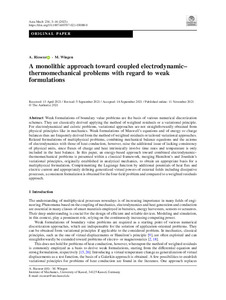| dc.date.accessioned | 2023-03-06T10:38:50Z | |
| dc.date.available | 2023-03-06T10:38:50Z | |
| dc.date.issued | 2021-11-11 | |
| dc.identifier | doi:10.17170/kobra-202302237532 | |
| dc.identifier.uri | http://hdl.handle.net/123456789/14466 | |
| dc.description.sponsorship | Gefördert im Rahmen des Projekts DEAL | ger |
| dc.language.iso | eng | eng |
| dc.rights | Namensnennung 4.0 International | * |
| dc.rights.uri | http://creativecommons.org/licenses/by/4.0/ | * |
| dc.subject.ddc | 620 | |
| dc.title | A monolithic approach toward coupled electrodynamic–thermomechanical problems with regard to weak formulations | eng |
| dc.type | Aufsatz | |
| dcterms.abstract | Weak formulations of boundary value problems are the basis of various numerical discretization schemes. They are classically derived applying the method of weighted residuals or a variational principle. For electrodynamical and caloric problems, variational approaches are not straightforwardly obtained from physical principles like in mechanics. Weak formulations of Maxwell’s equations and of energy or charge balances thus are frequently derived from the method of weighted residuals or tailored variational approaches. Related formulations of multiphysical problems, combining mechanical balance equations and the axioms of electrodynamics with those of heat conduction, however, raise the additional issue of lacking consistency of physical units, since fluxes of charge and heat intrinsically involve time rates and temperature is only included in the heat balance. In this paper, an energy-based approach toward combined electrodynamic–thermomechanical problems is presented within a classical framework, merging Hamilton’s and Jourdain’s variational principles, originally established in analytical mechanics, to obtain an appropriate basis for a multiphysical formulation. Complementing the Lagrange function by additional potentials of heat flux and electric current and appropriately defining generalized virtual powers of external fields including dissipative processes, a consistent formulation is obtained for the four-field problem and compared to a weighted residuals approach. | eng |
| dcterms.accessRights | open access | |
| dcterms.creator | Ricoeur, Andreas | |
| dcterms.creator | Wingen, Marius | |
| dc.relation.doi | doi:10.1007/s00707-021-03088-0 | |
| dc.subject.swd | Elektrodynamik | ger |
| dc.subject.swd | Thermomechanische Eigenschaft | ger |
| dc.subject.swd | Randwertproblem | ger |
| dc.subject.swd | Mathematisches Modell | ger |
| dc.subject.swd | Diskretisierungsverfahren | ger |
| dc.type.version | publishedVersion | |
| dcterms.source.identifier | eissn:1619-6937 | |
| dcterms.source.issue | Issue 1 | |
| dcterms.source.journal | Acta Mechanica | eng |
| dcterms.source.pageinfo | 3-16 | |
| dcterms.source.volume | Volume 234 | |
| kup.iskup | false | |


